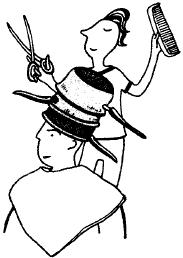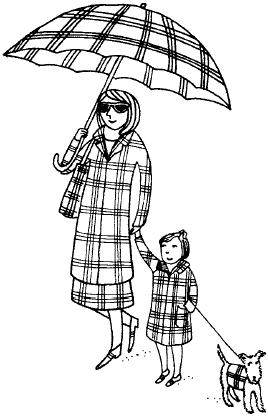
the day you decide to leavejour house naked is the dayjou run intojour in-laws
Whatever Nature has provided you with, you always have the chance to make your own improvements:
sulong (Iban, Sarawak and Brunei) to decorate the front teeth with gold (formerly brass)
nyin-susu (Bambara, West Africa) to blacken someone’s gums for cosmetic purposes
pen bilong maus (Tok Pisin, Papua New Guinea) lipstick
Rock (German) skirt
veste (French) jacket
romp (Afrikaans) skirt
cilinder (Hungarian) top hat
gulp (Dutch) fly (in trousers)
And hair is one very obvious place for the drastic makeover:
rikuruto-katto (Japanese) a short haircut supposed to impress prospective employers (literally, recruit cut)
wu-masweeswe (Kalanga, Botswana) shaving the hair in a sinuous outline across the forehead
emperifollado(a) (Latin American Spanish) dressed to kill, particularly when it involves a complicated hairdo
Topfschnitt (German) a certain haircut that looks a bit as if the hairdresser put a saucepan on someone’s head and cut all around it (literally, saucepan cut)

Make sure not to overdo it:
cerone (Italian) excessive make-up applied on one’s face (literally, grease paint)
itoyewaton (Dakota, USA) to wear anything that makes one look frightful
age-otori (Japanese) formally styling one’s hair for a coming of-age ceremony, but looking worse than before
Verschlimmerung (German) an improvement for the worse
die Fregatte (German) a heavily made-up old woman (literally, frigate)
yubisakibijin (Japanese) a woman who spends a lot of her salary tending to her fingernails
Though there are hundreds of poetic English words for different beautiful colours, there are very few for those at the less pleasant end of the spectrum. The Ojibway of North America say osawegisan, which means making something yellow with smoke, nicotine-stained. The Pali of India have a word for the bluish-black colour of a corpse – vinilaka – which literally means resembling neither father nor mother. The Amerindian Mingo words for the basic colours are just as evocative:
uiskwanyë’ta’ê’ the colour of rotten wood (brown)
unöwö’ta’ê’ the colour of limestone or plaster (white)
uyë’kwææ’ê’ the colour of smoke (grey)
tsitkwææ’ê’ the colour of bile (yellow)
Just because you can’t see your own backside doesn’t mean that others can’t. The Germans certainly notice these things:
Arschgeweih a large symmetrical tattoo on the lower back, just above the bottom, resembling the shape of antlers
Liebestoeter unattractive underwear (literally, love killer)
Maurerdekoltee a bricklayer’s cleavage (the part of a man’s backside you can see when he stoops deeply and his trouser waistband goes down a little bit)
All over the world, people enjoy escaping from their intractable shape in a fine outfit:
kambabalegkasan (Maguindanaon, Philippines) the act of wearing new clothes
sich auftakeln (German) to get all dolled up (literally, with all sails set)
housunprässit (Finnish) trouser creases
fifi (Argentinian Spanish) a fashion-conscious man, dandy
kopezya (Mambwe, Zambia) tipping his hat down over his eyes
pagalong (Maranao, Philippines) to look at oneself in the mirror
Though what works in one place won’t necessarily work in another:
nastā (Hindi) a hole bored in the septum of the nose
wo-kûs’-i-ûk (Maliseet, Canada) a necklace of claws
kechchai (Tamil) little tinkling bells tied to the legs
wowoodteyadla (Kaurna Warra, Australia) two or four kangaroo teeth bound together with hair and covered with grease and red ochre, worn on the forehead by fully initiated men
okpukpu (Igbo, Nigeria) an ivory bangle worn by women with ten or more children, and sometimes by men to demonstrate their proven expertise
borsello (Italian) a man’s handbag
‘Those who have fine clothes in their chests can wear rags,’ say the Italians, but in other parts of the world it’s not always true that the higher up you are in society the more likely you are to dress down:
s chuzhovo plecha (Russian) second-hand clothes (literally, from a stranger’s shoulder)
kamaeieia (Gilbertese, Oceania) to wear a garment until it is in tatters
xúng xính (Vietnamese) to be dressed in oversized clothes
mabelebele (Setswana, Botswana) the rags and tatters worn by a madman, a pauper or a traditional doctor
The two extremes of women’s intense relationship with clothes are chronicled by the Japanese. At one end there is nitto-onna, a woman so dedicated to her career that she has no time to iron blouses and so resorts to dressing only in knitted tops; and at the other there are ippaiyoku, women whose every garment and accessory are made by the same designer.

Most try to keep up with what everyone else is wearing, but there will always be some, thankfully, who remain gloriously independent:
cowichan (British Columbia, Canada) a vividly patterned sweater
buddi (Tamil) someone who wears thick glasses
lambung (Maguindanaon, Philippines) to wear very big clothes
agadagba (Igbo, Nigeria) men’s underpants woven from a mix of cotton, grass and tree bark
arse gras (Tok Pisin, Papua New Guinea) a bunch of tanket leaves stuck into a belt to cover a man’s backside
For as long as clothes have been around, people have sneered or laughed at what others have chosen to wear:
topeewalla (Hindi) one who wears a hat, generally a European
kampungan (Indonesian) someone who is incredibly out of fashion, outdated (literally, so village)
hemdsärmelig (German) someone who behaves very rustically (literally, shirt-sleeved)
ta-oiny (Car, Nicobar Islands) clothes-wearing foreigners
samopal (Russian) home-made clothing sold under commercial labels (literally, a home-made cap gun)
Though hopefully not what they put on their feet:
gállot (Sami, North Scandinavia) a shoe made out of hide taken from the head of a reindeer
fittocks (Scots) the feet of stockings cut off and worn as shoes
kirza (Russian) imitation leather boots
innesko (Swedish) an indoor shoe
jorg (Scots) the noise of shoes when full of water
But then again isn’t one of the most enjoyable things about dressing up coming home and stripping off?
huhu (Rapanui, Easter Island) to take off one’s clothes in one go, with a pull
byambula (Tsonga, South Africa) to walk in the open completely naked
Just make sure that when you get dressed again there’s no confusion…
vrenge (Norwegian) the action of putting right clothes which are inside out
lopodutes (Ancient Greek) one who slips into another’s clothes
terchausser (Gallo, France) to put the right foot into the left boot and vice versa
embasan (Maguindanaon, Philippines) to wear clothes while taking a bath
ngam tae rup, jub mai horm (Thai) great looks but bad breath
l’abito non fa il monaco (Italian) clothes do not make the monk
quern vê caras nāo vê coraçōes (Portuguese) he who sees face doesn’t see heart
odijelo ne čini čoyjeka (Croatian) a suit doesn’t make a man
het zijn niet alleen koks die lange messen dragen (Dutch) it’s not only cooks who carry long knives